英汉语言对比-术语翻译
- 格式:docx
- 大小:16.52 KB
- 文档页数:3
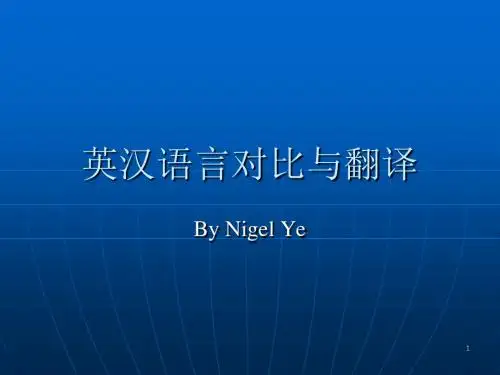
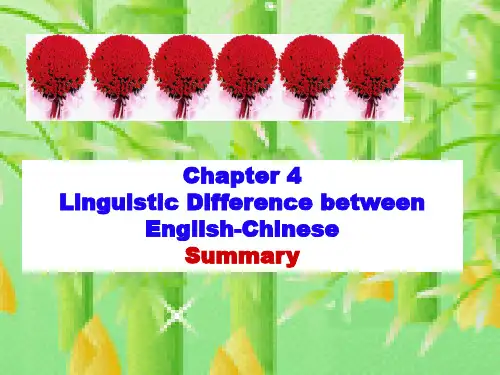
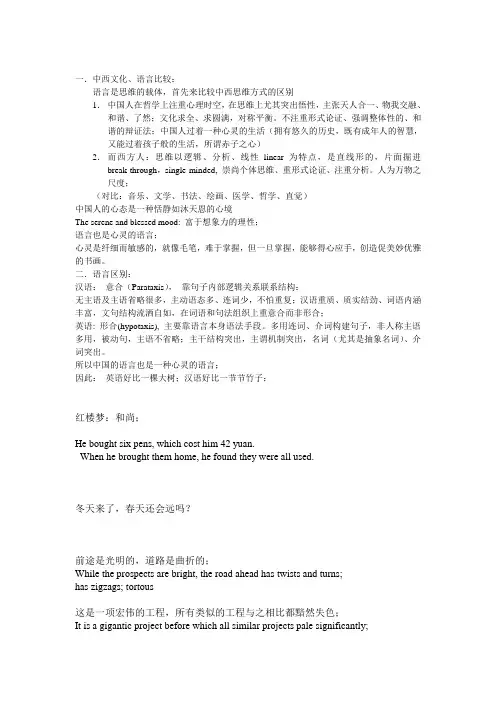
一.中西文化、语言比较:语言是思维的载体,首先来比较中西思维方式的区别1.中国人在哲学上注重心理时空,在思维上尤其突出悟性,主张天人合一、物我交融、和谐、了然;文化求全、求圆满,对称平衡。
不注重形式论证、强调整体性的、和谐的辩证法;中国人过着一种心灵的生活(拥有悠久的历史,既有成年人的智慧,又能过着孩子般的生活,所谓赤子之心)2.而西方人:思维以逻辑、分析、线性linear为特点,是直线形的,片面掘进break-through,single-minded, 崇尚个体思维、重形式论证、注重分析。
人为万物之尺度;(对比:音乐、文学、书法、绘画、医学、哲学、直觉)中国人的心态是一种恬静如沐天恩的心境The serene and blessed mood: 富于想象力的理性;语言也是心灵的语言;心灵是纤细而敏感的,就像毛笔,难于掌握,但一旦掌握,能够得心应手,创造促美妙优雅的书画。
二.语言区别:汉语:意合(Parataxis),靠句子内部逻辑关系联系结构:无主语及主语省略很多,主动语态多、连词少,不怕重复;汉语重质、质实结劲、词语内涵丰富,文句结构流洒自如,在词语和句法组织上重意合而非形合;英语: 形合(hypotaxis), 主要靠语言本身语法手段。
多用连词、介词构建句子,非人称主语多用,被动句,主语不省略;主干结构突出,主谓机制突出,名词(尤其是抽象名词)、介词突出。
所以中国的语言也是一种心灵的语言;因此:英语好比一棵大树;汉语好比一节节竹子;红楼梦:和尚;He bought six pens, which cost him 42 yuan.When he brought them home, he found they were all used.冬天来了,春天还会远吗?前途是光明的,道路是曲折的;While the prospects are bright, the road ahead has twists and turns;has zigzags; tortous这是一项宏伟的工程,所有类似的工程与之相比都黯然失色;It is a gigantic project before which all similar projects pale significantly;典型的例子就是连词:so…. that 和when….1.What was the forbidden city in Beijing like? It wasso interesting that I went several times.北京的紫禁城是个什么地方?它是如此有趣以至我去参观了好几次;When 也不是总译成当…..时候..甚至大部分时间不译成“当……时候”有时甚至出现:“当他转过身来看见我手里握着那根上面刻着亨利.史密斯的名字的旧鱼竿的时候….”这样的怪句子;2.汉语:远看山有色,近听水无声,春去花还在,人来鸟不惊;英语:When you look afar, the mountains are green and clear;But no sound of stream is heard when listening near.The flowers remain in full bloom when spring’s away,A human being’s approach the bird doesn’t fray.汉语是婴儿语言;(1)隐含条件从句的意合早知今日,何必当初;If I had known it would come to this, I would have acted differently.(2)隐含结果从句的意合;He spoke so rapidly that we could not clearly understand him.他说得太快,我们不能理解他的意思;It was so cold that the river froze.天气寒冷,河水都结冰了;It couldn’t make out who he was as I only saw his back;我只见到他的背影,认不清是谁;(3)隐含转折的意合:江山易改,本性难移;It is easy to change rivers and mountains but hard to change a person’s nature.三.英汉两种语言句型具体区别及翻译中的应用:核心区别:汉语:并列型coordination, 表面上是没有主次之分的;英语:从属型subordination,一定是有主次之分的;Eg.7 将国有企业提供社会保障待遇与雇佣关系脱钩,这将有助于使国企经理在作出商业决策时不用考虑政府对社会问题的顾虑,同时还可使员工在调动工作不用担心失去社会福利待遇,这就能够提高劳动力的流动性。
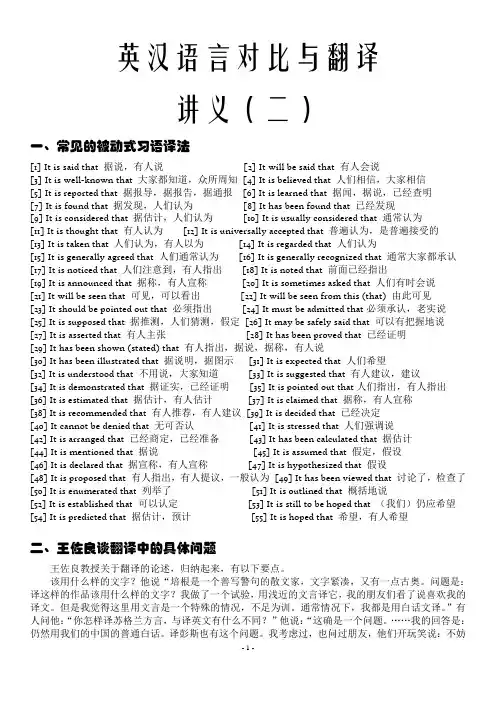
英汉语言对比与翻译讲义(二)一、常见的被动式习语译法[1] It is said that 据说,有人说[2] It will be said that 有人会说[3] It is well-known that 大家都知道,众所周知[4] It is believed that 人们相信,大家相信[5] It is reported that 据报导,据报告,据通报[6] It is learned that 据闻,据说,已经查明[7] It is found that 据发现,人们认为[8] It has been found that 已经发现[9] It is considered that 据估计,人们认为[10] It is usually considered that 通常认为[11] It is thought that 有人认为[12] It is universally accepted that 普遍认为,是普遍接受的[13] It is taken that 人们认为,有人以为[14] It is regarded that 人们认为[15] It is generally agreed that 人们通常认为[16] It is generally recognized that 通常大家都承认[17] It is noticed that 人们注意到,有人指出[18] It is noted that 前面已经指出[19] It is announced that 据称,有人宣称[20] It is sometimes asked that 人们有时会说[21] It will be seen that 可见,可以看出[22] It will be seen from this (that) 由此可见[23] It should be pointed out that 必须指出[24] It must be admitted that必须承认,老实说[25] It is supposed that 据推测,人们猜测,假定[26] It may be safely said that 可以有把握地说[27] It is asserted that 有人主张[28] It has been proved that 已经证明[29] It has been shown (stated) that 有人指出,据说,据称,有人说[30] It has been illustrated that 据说明,据图示[31] It is expected that 人们希望[32] It is understood that 不用说,大家知道[33] It is suggested that 有人建议,建议[34] It is demonstrated that 据证实,已经证明[35] It is pointed out that人们指出,有人指出[36] It is estimated that 据估计,有人估计[37] It is claimed that 据称,有人宣称[38] It is recommended that 有人推荐,有人建议[39] It is decided that 已经决定[40] It cannot be denied that 无可否认[41] It is stressed that 人们强调说[42] It is arranged that 已经商定,已经准备[43] It has been calculated that 据估计[44] It is mentioned that 据说[45] It is assumed that 假定,假设[46] It is declared that 据宣称,有人宣称[47] It is hypothesized that 假设[48] It is proposed that 有人指出,有人提议,一般认为[49] It has been viewed that 讨论了,检查了[50] It is enumerated that 列举了[51] It is outlined that 概括地说[52] It is established that 可以认定[53] It is still to be hoped that (我们)仍应希望[54] It is predicted that 据估计,预计[55] It is hoped that 希望,有人希望二、王佐良谈翻译中的具体问题王佐良教授关于翻译的论述,归纳起来,有以下要点。
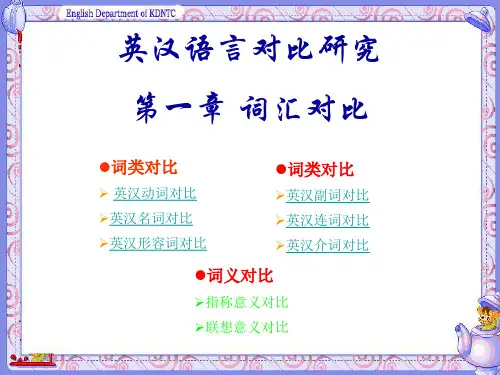



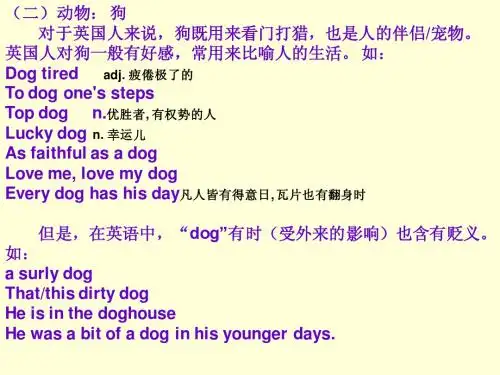
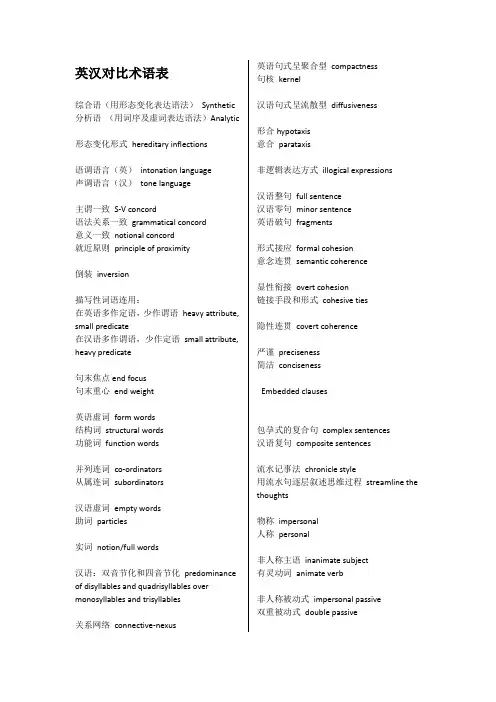
英汉对比术语表综合语(用形态变化表达语法)Synthetic 分析语(用词序及虚词表达语法)Analytic形态变化形式hereditary inflections语调语言(英)intonation language声调语言(汉)tone language主谓一致S-V concord语法关系一致grammatical concord意义一致notional concord就近原则principle of proximity倒装inversion描写性词语连用:在英语多作定语,少作谓语heavy attribute, small predicate在汉语多作谓语,少作定语small attribute, heavy predicate句末焦点end focus句末重心end weight英语虚词form words结构词structural words功能词function words并列连词co-ordinators从属连词subordinators汉语虚词empty words助词particles实词notion/full words汉语:双音节化和四音节化predominance of disyllables and quadrisyllables over monosyllables and trisyllables关系网络connective-nexus 英语句式呈聚合型compactness句核kernel汉语句式呈流散型diffusiveness形合hypotaxis意合parataxis非逻辑表达方式illogical expressions汉语整句full sentence汉语零句minor sentence英语破句fragments形式接应formal cohesion意念连贯semantic coherence显性衔接overt cohesion链接手段和形式cohesive ties隐性连贯covert coherence严谨preciseness简洁concisenessEmbedded clauses包孕式的复合句complex sentences汉语复句composite sentences流水记事法chronicle style用流水句逐层叙述思维过程streamline the thoughts物称impersonal人称personal非人称主语inanimate subject有灵动词animate verb非人称被动式impersonal passive双重被动式double passive客观objective间接indirect婉转roundabout不提及行为者的被动式agentless passive公文文体bureaucratese科技文章technical writing报刊文章newspaperese无主句subjectless sentences主语省略句subject-omitted sentences祈使句或无形式标志的被动句passives with no grammatical marks被动passive主动active施事agent受事主语receptor subject含糊的人称主语vague pronoun subject信息性文本informative texts客观叙述impersonal activity seen objectively结构被动句syntactic passive意义被动句notional passive汉语“被字式”为不幸语态inflictive voice 通称generic person静态static动态dynamic名词化nominalization“名词优于动词”的倾向preponderance of nouns over verbs名词化表达法nominal style过分使用名词的习惯noun habit过分使用被动语态的习惯passive habit 堆砌名词noun pileups名词代替形容词noun adjectives削弱或淡化dilute弱化表达法debilitated style使叙述曲折迂回circumlocution弱式动词verbs of feeble phenomenality抽象abstract具体concrete大字眼pompous words行为抽象名词action-nouns范畴词category words具体化figuration间接indirect直接direct委婉euphemism官方英语officialese官僚英语bureaucratese五角大楼英语Pentagonese国务院英语State-Departmentese官腔英语gobbledygood地方市政府英语urbanbabble职业委婉语occupational euphemism含蓄implicitness转移否定transferred negation臆断assumptions含蓄虚拟句implied subjunctive反意问句disjunctive questions省略句ellipsis诅咒语swear-words讽刺语ironical idioms迂回periphrasis行话jargon替换substitutive重复reiterative替代substitution替代的形式pro-forms名词性替代nominal substitution 动词性替代verbal substitution分句性替代clausal substitution省略omission变换variation变相重复elegant variation上义词generic term下属词specific words上下义词hyponymy重叠reduplication重复repetition对照antithesis排比parallelism第三人称单数third person singular。
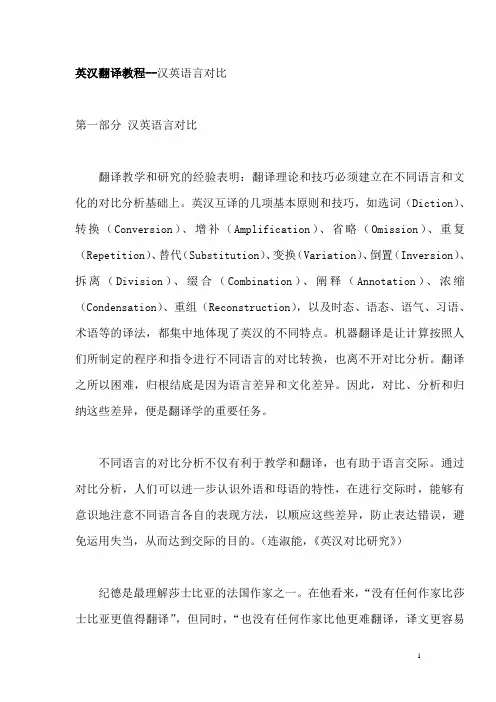
英汉翻译教程--汉英语言对比第一部分汉英语言对比翻译教学和研究的经验表明:翻译理论和技巧必须建立在不同语言和文化的对比分析基础上。
英汉互译的几项基本原则和技巧,如选词(Diction)、转换(Conversion)、增补(Amplification)、省略(Omission)、重复(Repetition)、替代(Substitution)、变换(Variation)、倒置(Inversion)、拆离(Division)、缀合(Combination)、阐释(Annotation)、浓缩(Condensation)、重组(Reconstruction),以及时态、语态、语气、习语、术语等的译法,都集中地体现了英汉的不同特点。
机器翻译是让计算按照人们所制定的程序和指令进行不同语言的对比转换,也离不开对比分析。
翻译之所以困难,归根结底是因为语言差异和文化差异。
因此,对比、分析和归纳这些差异,便是翻译学的重要任务。
不同语言的对比分析不仅有利于教学和翻译,也有助于语言交际。
通过对比分析,人们可以进一步认识外语和母语的特性,在进行交际时,能够有意识地注意不同语言各自的表现方法,以顺应这些差异,防止表达错误,避免运用失当,从而达到交际的目的。
(连淑能,《英汉对比研究》)纪德是最理解莎士比亚的法国作家之一。
在他看来,“没有任何作家比莎士比亚更值得翻译”,但同时,“也没有任何作家比他更难翻译,译文更容易走样”。
纪德对莎士比亚的理解是双重的,既是精神的,也是语言的。
他在与莎士比亚的相遇与相识中,经历了一系列的考验。
对他在翻译中经历的这番历史奇遇,他曾在为七星文库出版的《莎士比亚戏剧集》撰写的前言中作了详尽的描述:描述了两种文化与两种语言之间的遭遇,也揭示了翻译中译者所面临的种种障碍。
纪德首先看到的,是语言与文化层面的逻辑性,这涉及到不同语言的思维方法。
他说:“莎士比亚很少考虑逻辑性,而我们拉丁文化缺了逻辑性就踉踉跄跄。
1. 语言的普遍特征:任意性arbitrariness双层结构duality 既由声音和意义结构多产性productivity移位性displacement:我们能用语言可以表达许多不在场的东西文化传播性cultural transmission2。
语言的功能:传达信息功能informative人济功能:interpersonal行事功能:Performative表情功能:Emotive寒暄功能:Phatic娱乐功能recreational元语言功能metal lingual3. 语言学linguistics:包括六个分支语音学Phonetics音位学phonology形态学Morphology句法学syntax语义学semantics语用学pragmatics4. 现代结构主义语言学创始人:Ferdinand de saussure提出语言学中最重要的概念对之一:语言与言语language and parole ,语言之语言系统的整体,言语则只待某个个体在实际语言使用环境中说出的具体话语5. 语法创始人:Noam Chomsky提出概念语言能力与语言运用competence and performance1. Which of the following statements can be used to describe displacement. one of the unique properties of language:a. we can easily teach our children to learn a certain languageb. we can use both 'shu' and 'tree' to describe the same thing.c. we can u se language to refer to something not presentd. we can produce sentences that have never been heard before.2.What is the most important function of language?a. interpersonalb. phaticc. informatived.metal lingual3.The function of the sentence "A nice day, isn't it ?"is __a informativeb. phaticc. directived. performative4.The distinction between competence and performance is proposed by __a saussureA linguistic study is descriptive if it describes and analyses facts observed; it is prescriptive if it tries to lay down rules for "correct" behavior.3.3 Synchronic(共时) and Diachronic(历时) StudiesThe description of a language at some point in time is a synchronic study and The description of a language as it changes through time is a diachronic study.3.4 Langue(语言) and Parole(言语)This is a distinction made by the Swiss linguist F.De Saussure (索绪尔)early last century. langue refers to the abstract linguistic system shared by all the members of a speech community and parole refers to the actualized(实际的) language, or realization of langue.3.5 Competence(能力)and Performance(行为)Competence is the ideal language user's knowledge of the rules of his language. Performance is the actual realization of this knowledge in utterances(发声).4. The Scope of LinguisticsGeneral linguistics is the study of language as a whole. Phonetics(语音学) is the branch of linguistics which studies the characteristics of speech sounds and provides methods for their description, classification and transcription.Phonology(音韵学) is the branch of linguistics which studies the sound patterns of languages.Morphology(词法) is the branch of linguistics which studies the form of words. Syntax(句法) is the branch of linguistics which studies the rules governing the combination of words into sentences.Semantics(语义学) is the branch of linguistics which studies the meaning of language. Applied linguistics(应用语言学) is the study of the teaching of foreign and second languages.Sociolinguistics is the study of the relationship between language and society. Psycholinguistics is the study of the relationship between language and the mind. Historical Linguistics(历史语言学) is the study of language changes. Anthropological linguistics(人文语言学) uses the theories and methods of anthropology to study language variation and language use in relation to the cultural patterns and beliefs of man.Neurolinguistics(神经语言学) studies the neurological basis of language development and use in human beings.Mathematical linguistics(数学语言学) studies the mathematical features of language, often employing models and concepts of mathematics.Computational linguistics(计算语言学) is an approach to linguistics in which mathematical techniques and concepts are applied, often with the aid of a computer. II. Phonetics(语音学)1. scope of phoneticsSpeech sounds may be studied from different angles, thus we have at least three branches of phonetics:Articulatory phonetics(发音语音学)we may examine the way in which a speech sound is produced to discover which vocal organs are involved and how they coordinate(协调)in the process.Auditory phonetics (听觉语音学)we may look into the impression a speaker makes on the hearer as mediated(调节)by the ear, the auditory nerve(神经)and the brain.Acoustic phonetics (声学语音学)we study the physical properties of speech sounds, as transmitted(传送)between mouth and ear.2. The vocal organsThe vocal organs may be viewed as consisting of three parts, the initiator of the air-stream,(气流发生器官)the producer of voice(声音发生器官)and the resonating cavities.(声音共振器官)3. Consonants(辅音)Places of articulation(发音部位): bilabial,(双唇)Labiodentals,(唇齿)dental,(齿)alveolar,(齿龈)retroflex,(卷舌)palate-alveolar,(上齿龈)palatal,(上颚)velar,(软腭)uvular,(小舌)glottal(声门)Manners of articulation: plosive,(暴破)nasal,(鼻音)trill,(颤音)lateral,(边音)fricative,(摩擦)approximant,(近似音)affricate(破擦)4. Vowels (元音)The classification of vowels: the height of tongue raising (high, mid, low), the position of the highest part of the tongue(front, central, back), and the degree of lip rounding(rounded, unrounded)III. Phonology(音韵学)1. phonemes(音素):a distinctive(有区别的)sound in a language.2. Allophones(音位变体):The nondistinctive sounds are members of the same phoneme.3. Minimal pairs(最小对立体):word forms which differ from each other only by one sound.4. Free variation (自由变异):If two sounds occurring in the same environment(环境), they does not produce a different word form, but merely a different pronunciation of the same word.5. Complementary distribution(补充分类):Not all the speech sounds occur in the same environment. When two sounds never occur in the same environment.6.Suprasegmental phonology(超音段音位):the study of phonological properties(性质)of units lager than the segment-phoneme. They are syllable(音节),stress,(重音)word stress, sentence stress. pitch (音调)and intonation(语调).IV. Morphology(词法)1. inflection(构形法):the grammatical relationships through the addition of inflectional affixes.(屈折词缀)2. Word-formation(构词):the processes(过程)of word variations signaling lexical relationships.(表明词法关系)They are compound(合成)and derivation (派生).3. Morpheme(词素):the smallest unit in terms of relationship between expression and content.4. Allomorph(同质异象变体):some morphemes have considerable variation, for instance, alternate shapes or phonetic forms.5. Types of morphemes: They are roots,(词根)affix(词缀)and stem(词干).6. Lexicon(语言词汇):in its most general sense, is synonymous with vocabulary.7. Closed-class words(封闭性)and open-class words(开放性):the former whose membership is fixed or limited and the latter whose membership is in principle(实际上)indefinite or unlimited.8. Word class(词性):It displays a wider range of more precisely defined classes.9. Lexeme(词位):the smallest unit in the meaning system of a language that can be distinguished from other smaller units.10. Idiom(习语,成语):Most phrasal lexemes are idioms. It is especially true for a sequence of words(词序)which is semantically(语义上)and often syntactically(句法上)restricted.(限制)11. Collocation(搭配):the habitual(习惯的)co-occurrences (同时出现)of individual lexical items.V. Syntax (句法)1. Positional relation or word order(词序):the sequential(顺序)arrangement of words in a language.2. Construction or constituent (句子结构):the overall process of internal (内部)organization of a grammatical unit .3. Syntactic function(句法功能):the relationship between a linguistic form and other parts of the linguistic pattern in which it is used. The names of functions are expressed in terms of subjects, objects, predicates, modifiers,(修饰语)complements(补语), etc.4. Category(范畴):It refers to classes and functions in its narrow sense, e.g. noun, verb, subject, predicate, noun phrase, verb phrase, etc. The categories of the noun include number, gender, case and countability.5. Phrase: a single element of structure containing more than one word, and lacking the subject-predicate structure typical of clause.6. Clause: a group of words with its own subject and predicate, if it is included in a larger sentence.7. Sentence: It is the minimum part of language that expresses a complete thought. VI. Semantics1. Conceptualism or mentalism (概念主义):Following F. De Saussure(索学尔)'s "sign" theory, the linguistic sign is said to consist of a signifier(所指)and signified(被指), i.e., a sound image and a concept, liked by a psychological(心理的)"associative" bond.(相关联系)2. Mechanism(机械主义):Some linguists, Bloomfield,(布鲁费尔德)for example, turned to science to counter(反)-act the precious theories and this leads to what call the mechanistic approach(方法). The nature of this theory has nothing to do with the scientific study of mental phenomena.(智力现象)3. Contextualism (语境主义):It is based on the presumption(假定)that one can derive meaning from or reduce it to observable context.4. Behaviorism (行为主义):Behaviorists attempt to define (定义)the meaning ofa language form as "the situation(情景)in which the speaker utters(说话)it and the response(反应)it calls forth in the hearer."Compounding合成词)etymology.(词源变化)14. Orthographic change :(正字法)Changes can also be found at the graphitic level.。
1.dynamicity of language 语言的动态性
It refers to a distinctive feature of Chinese. Compared with English, Chinese have a much higher degree of dynamicity. It puts more emphasis on motion or action, which finds its expression in verbs and adverbs; however, English seems to lay more focus on the concept, as is expressed by nouns.
例:你怎么看?How do you think? What do you think?
2.semantic motivation 语义理据
It refers to the mental associations of the conceptual meaning of a word. It explains the connection between the literal meaning and figurative meaning of a word. It can be achieved through rhetorical devices such as metaphor, hyperbole, analogy, metonymy and image.
例:metaphor: 喇叭花,纸老虎,鹅卵石
3.lexical gap 词汇空缺
Lexical gap refers to the fact that no corresponding lexical items of the source language can be found in the target language. There are several causes for such gaps: different motivations behind nomenclature, different ways of grouping things, differences among synonyms, and things unique to a culture, etc.
例:billions, millions
4.parataxis 意合
It means that the connections between sentences depend on the meanings of the languages or their logical relationship. Compared with English, Chinese is more paratactic because of its perceptional thing and holistic comprehension.
例:留得青山在,不怕没柴烧。
As long as the green mountains are there, one should not worry about firewood.
In Chinese, there is no word to join the two clauses, but their English translations must have
conjunctions.
5.Conceptual metaphor 概念隐喻
Conceptual metaphor is defined as understanding one conceptual domain called a target domain in terms of another conceptual domain called a source domain.
for example, in the sentence “Life is a journey.”, “life” is the target domain while “journey” is the source domain.
6.phonographic language 表音文字
It means that its letters only stand for sounds. Only a combination of sounds can represent a meaning. English is a phonographic language, whose letters do not represent any meaning, whereas Chinese is a morpheme language or an ideographic language, who characters represent particular meanings.
7.intonation 语调
It refers to the pitch pattern changes in connected speech. It mainly concerns the syntactic level and is used to distinguish questions from statements. At the syntactic level, English is an intonation language while Chinese is a contour tone language.
8.lexicalization 词汇化
It refers to a word formation process of adding words, set phrases, or word patterns to a language. It is the realization of a meaning in a single word or morpheme rather than in a grammatical construction.
9.nominalization 名词化
The process of forming a noun or noun phrases from a clause or a verb. This phenomenon shows the objectivity and conciseness of English language.
10.cohesion 衔接
It refers to the grammatical and lexical relationships between the different elements of a discourse, which can be achieved through reference, substitution, ellipsis, conjunction and lexical cohesion.。